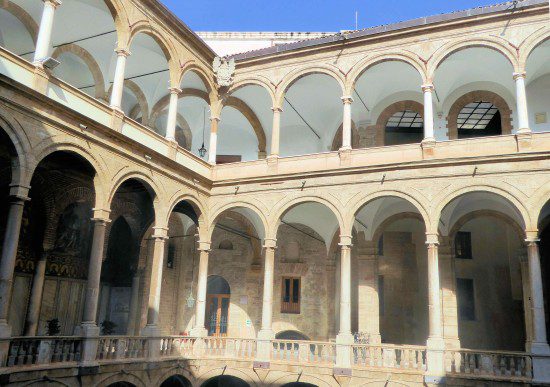Palermo: the Arab-Norman Marriage
Expecting the rain to begin at any moment as forecast, I made sure to pack my raincoat before setting off and resolved to walk the city before I would surely be relegated to indoor sights.
In fact, it stayed sunny and warm throughout the day!
First I did a little shopping, picking up a couple of tops at Blue Sand, an Italian brand selling colorful low-cost fashion.
This made me work up an appetite. I stumbled on Bar Touring around the port where an array of salads, stews, lasagnas and sweets were displayed behind a glass. People streamed in and out with their takeaway treats but fortunately there were a few tables. I ordered both the octopus salad and the vegetable stew, having no idea the portions would be so large. Each was delectable.

 How is it possible that tomatoes, potatoes, olives and green beans could be SO GOOD?
How is it possible that tomatoes, potatoes, olives and green beans could be SO GOOD?
Well fortified, I decided to head to Palermo’s premier sight, the Norman Palace, now the seat of the Sicilian Parliament. Like so much in Palermo, it reflects a synthesis of Moorish and Norman styles. Built in the 9th century, it was transformed when King Roger II swept in with his Norman army and made the palace his own. Unlike almost every other Christian ruler, he decided that his court had a lot to learn from the Arabs whom he enlisted both as artisans to work on the building and high-level aides to help him run the place. Was this the last time that Islam and Christianity coexisted peacefully and productively? Maybe.
Many of the rooms are closed off when Parliament is in session but the central courtyard gives an idea of the fusion of elements:
 But the highlight is undoubtedly the exquisite Palatine Chapel, a glittering 12th-century jewel of a chapel encrusted with mosaics, inlaid marble and a muqarnas ceiling.
But the highlight is undoubtedly the exquisite Palatine Chapel, a glittering 12th-century jewel of a chapel encrusted with mosaics, inlaid marble and a muqarnas ceiling.
 There was just so much to look it; the painstaking workmanship and extraordinary level of artistry was mesmerizing.
There was just so much to look it; the painstaking workmanship and extraordinary level of artistry was mesmerizing.
 It was hard to leave but leave I did. I took at look at the Cathedral but didn’t visit.
It was hard to leave but leave I did. I took at look at the Cathedral but didn’t visit.
Rather than queuing up for the Cathedral I decided to pursue the Arab-Norman theme and visit La Zisa, constructed by Arab craftsmen in the 12th century as a residence for the Norman kings.
It was a looooong, hot walk as I passed through crumbling neighborhoods of haphazardly constructed postwar buildings. I needed a rest and an ice cream. Why not a brioche con gelato in which gelato is smooshed into a brioche-style roll? An ice cream sandwich Palermo style! Why doesn’t everyone eat ice cream this way? Who ever thought of cones anyway?
On to La Zisa which was again a startling reminder of Sicily’s Moorish underpinnings.

via Commons.
 I was glad that funds were found to restore the frescoes and other architectural features inside.
I was glad that funds were found to restore the frescoes and other architectural features inside.
After walking about 20 miles and eating a ton, I was happy to collapse in my room and plan the rest of my itinerary.
It was a good thing I had no dinner plans as the much anticipated rains came at nightfall. The storm was so intense it knocked out the power for 20 minutes or so. My hosts informed me this was most unusual, even for October.



Comments
Palermo: the Arab-Norman Marriage — No Comments
HTML tags allowed in your comment: <a href="" title=""> <abbr title=""> <acronym title=""> <b> <blockquote cite=""> <cite> <code> <del datetime=""> <em> <i> <q cite=""> <s> <strike> <strong>